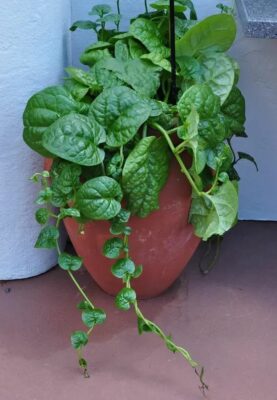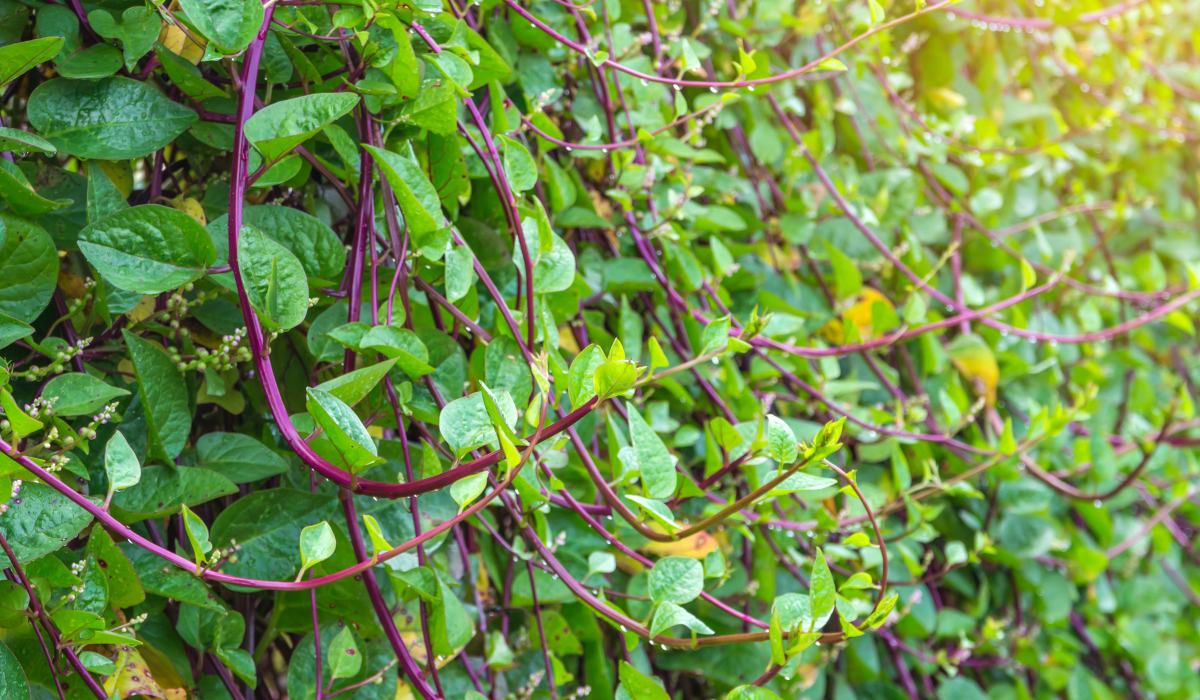Spinach is frequently used in spring salad combinations and is connected with the season of spring, and for a good reason—spinach thrives in chilly climates. Spinach bolts in the summer due to the prolonged sunshine hours and high temperatures. Consider Malabar spinach as a replacement if growing it in the spring or fall isn’t enough to sate your craving for spinach.
Malabar spinach, or Basella alba, is a tropical leafy green that bears the name of a southern Indian coastal region. Even though it differs botanically from actual spinach, it looks like it. The other common names of this plant are vine spinach, Ceylon spinach and Indian spinach. The shoots, which are oval or heart-shaped, and the dark green, glossy leaves, can be cooked or eaten raw in salads.
Malabar spinach has a mild flavour that is comparable to spinach, with hints of pepper and citrus. However, after cooking, the texture is distinct from spinach. Similar to okra, the thick, semi-succulent leaves turn gluey.
Malabar spinach requires a trellis to sustain its rapid growth because it grows vertically. It can be grown as a perennial plant in hot locations with frost-free winters, but otherwise, it is an annual vegetable like spinach. It is a beautiful addition to a garden bed in addition to being an edible plant, particularly the red-leaf type.
Malabar spinach: Quick facts
| Species name | Basella alba |
| Family name | Basellaceae |
| Synonyms | Malabar spinach, Indian spinach, Vine spinach, etc. |
| Height | 6-10 feet tall |
| Genus’s name | Basella |
| Native area | South and Southeast Asia and Indian subcontinent |
| Environmental impact | Positive |
| Maintenance | Low |
| Plant type | Vegetable |
Source: Pinterest
How to grow Malabar Spinach from seed?
- Malabar spinach seeds typically start to germinate in 10 to 20 days.
- The seeds will expand more rapidly in the summer.
- After the seeds have germinated, separate the weak seedlings, then transplant the stronger ones only after determining which leaves are the real leaves in the intended location.
- Tip: Soak the seeds in water overnight before planting them if you want them to sprout more quickly.
Malabar spinach growth from cuttings
The simplest method for growing Malabar spinach is to start with cuttings.
- A 5- to 6-inch-long cutting from the plant is made below the node.
- Plant the cutting where you want it to grow once it is ready. Ensure that the soil is well-drained.
- The roots will show themselves, and the plant will begin to grow in about two weeks.
Malabar spinach plantation in pots
Here are a few things to bear in mind when growing Malabar spinach in pots.

Source: Pinterest
Plant placement
One of the veggies that thrives in the shadow is Malabar spinach. You can cultivate the plant in direct sunshine during the summer. Simply ensure that the plant receives 4 to 5 hours of direct sunlight each day because this is excellent for growth.
Place the plant in a location that receives sunshine when it’s winter or when the weather is cold. Place the plant in the warmest area of your patio, balcony, or yard.
Use the right quantity of soil
Keep in mind that the Malabar spinach needs pH-neutral, well-drained soil when growing it. To enhance the texture and richness of the soil, mix in about 20% of aged manure or compost.
Add roughly two parts sterilised garden soil, one part compost, and one part peat moss or coco peat to make the best DIY potting mix.
Fertilisers for your plant
You don’t need any further feeding if you’ve used compost to improve the soil, but if you haven’t, apply balanced liquid fertiliser once every 4 to 8 weeks in a sparing dose.
The plant needs water
Please remember that in order to keep the soil moist, you must water the plant frequently and consistently. Maintaining an equal moisture level in the soil is essential to growing Malabar spinach.
Support the plants appropriately
Malabar spinach requires vertical support due to its tenacious climbing ability. Therefore, to facilitate easy growth, affix a trellis or string to the plant’s top. Malabar spinach can grow up to 15 feet in length on average.
Malabar spinach: Care and maintenance
Light
Malabar spinach can tolerate some shade but thrives in direct sunlight. In fact, the size and succulent property of its leaves may grow in sunny or dappled shade.
Soil
Malabar spinach doesn’t have any particular soil requirements; therefore, it can grow in a variety of soil types. It prefers sandy loam that drains well and is rich in organic matter, although it can also survive damp soil as long as it is not waterlogged.
Water
Malabar spinach requires quite a bit of water. It will prematurely flower in dry conditions, which can make the leaves bitter. It needs to be watered frequently when there isn’t regular, adequate rainfall. On the other hand, excessive precipitation is typically not a concern unless the land has poor drainage.
Humidity and temperature
Malabar spinach is a tropical plant that is particularly susceptible to frost; it not only freezes to death but also requires heat to grow. You won’t notice much development at daytime temperatures below 80 degrees F and overnight temperatures below 60 degrees F. Only when the temperature rises above 90 degrees F does the plant begin to thrive.
Fertiliser
For robust leaf growth, Malabar spinach, like most greens, requires a high-nitrogen fertiliser. Give it a slow-release fertiliser application once at the time of planting and one more every three to four weeks throughout the growing season.
Pruning
Malabar spinach may tangle up and go out of control like any other vine. Regular harvesting may not be sufficient to maintain its shape after it takes off; extra pruning of the fleshy stems and leaves may be required.
Untrimmed vines can grow up to 30 feet in length. You may encourage the plant to branch out by pinching the tips of the vines.
See more about Leafy vegetables: A guide to having a healthy and green vegetable garden
Malabar spinach: Uses
Blood pressure control
Potassium, an important mineral that can help lessen the effects of sodium in the body, is found in Malabar spinach. Potassium also aids in reducing tension in the blood vessel walls, which lowers blood pressure.
Enhances vision
This is fantastic news for your eyes. Malabar spinach contains a type of vitamin A called beta-carotene, which the body can use to make vitamin A.
Assists in weight loss
Both the soluble and insoluble fibre found in spinach have positive impacts on your health. Since it adds volume as the food moves through the digestive tract, soluble fibre can aid in weight loss through good digestion.
Improves cognitive performance
A 2015 study that was published in NCBI suggested that eating three servings of Malabar spinach could decrease mental deterioration by as much as 40%.
Reduces inflammation
This leafy green vegetable contains strong anti-inflammatory qualities that aid in the treatment of chronic inflammation in the body’s cells and tissues.
Heart health
Malabar spinach includes nitrite, which treats heart conditions caused by fatty deposits (compounds found naturally in some meals).
Can Malabar spinach be eaten raw?
The Malabar spinach leaves and stem tips are a good source of calcium, iron, vitamins A and C. Malabar spinach can be eaten raw in salads, boiled, stir-fried, cooked, added to soups, made into stews and curries and consumed. Consumption of Malabar spinach on a regular basis helps prevent osteoporosis and conditions related to anemia.
FAQs
How long does it take Malabar spinach to mature?
After seed sowing, the days to maturity range from 70 to 85. Baby green leaves can be harvested in as little as 50 days when they are cultivated under perfect circumstances.
Do you need a trellis to grow Malabar spinach?
Without a doubt. It is a climbing vine that needs to be cultivated on a trellis or other structure to keep it from sprawling out all over the place.
Are the berries from Malabar spinach edible?
Although the berries are used as a food colouring in Asia, where Malabar spinach originally came from, there is no information on their safe consumption or nutritional worth.
| Got any questions or point of view on our article? We would love to hear from you.
Write to our Editor-in-Chief Jhumur Ghosh at jhumur.ghosh1@housing.com |






